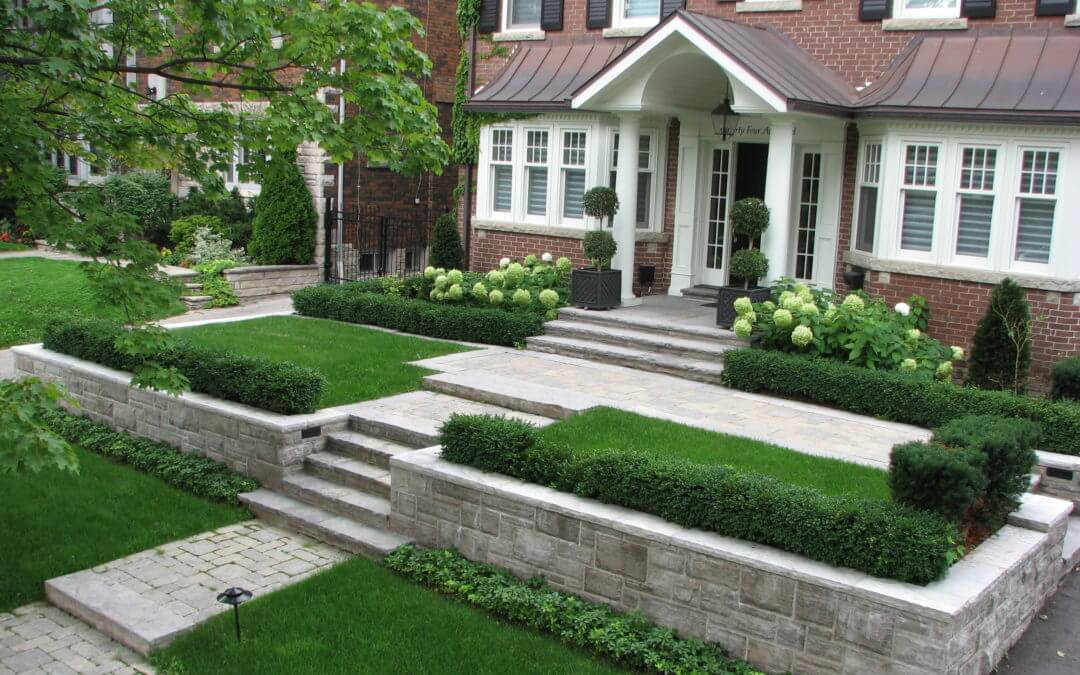In residential design, the layout and materials of walkways are critical to the function and style of a property. They can range from being a very practical direct way for people to enter the home, to a meandering path that allows someone to look around and enjoy the surrounding landscape . When laying out the front walkway start by looking at the architectural style of your home. Is your home modern or traditional? Are you looking for a formal or informal style? A formal entrance may be accomplished with a strongly symmetrical design or with plant material that is very clipped and contained. A more relaxed style will have sweeping curves with hidden views and a sense of discovery. Changes in elevation or materials will cause people to slow down and these provide a great opportunity to add a focal point that will mark this transition and add to the overall experience. If there is a large change in grade to deal with, it is best to break it up with landings between shorter sets of stairs. When building a walkway, the proper construction methods will ensure that your walkway is safe and does not pose any trip hazards. Proper excavation and compaction of the base is very important in our climate, as the freeze/thaw cycle during the winter months takes a toll on all materials. Drainage is also critical when building a walkway to ensure that there is no ponding or drainage across a walkway that can lead to dangerous winter ice. The layout of your walkway will also influence the maintenance of your property such as the ease of cutting your lawn. Long curves and wide angles are easier to maintain without a lot of trimming. There are many colors available to work with, especially when it comes to manmade products. The differences in color may be subtle, such as when using a color blend. Differing colors can also be used as banding or outlining to emphasize contrast and design details. The surface of the material also needs to be considered. For a walkway to your front door that is going to be used multiple times a day, you want a material that is not slippery or uneven to walk on. You will need to clear this walkway in the winter and some materials are damaged by salt which means more manual labour and maintenanced. A rough cobblestone path or pea gravel pathway will cause you to slow down as you navigate the uneven surface. You may not want this leading to your front door but perhaps leading to a bench in the back of our garden it can add to the experience. Plant material also has a great impact on your walkway. A crisp and clean look can be achieved with a low neat boxwood hedge that maintains a consistent line throughout the year, while others prefer a relaxed look with plant material spilling over the edge of the walkway and softening the edges. Using perennials adjacent to a walkway will ensure that it always changing, and the floral colors and scent can add to the overall experience. There are numerous considerations to be taken into account before the final layout and construction of a walkway takes place. It is a critical decision that sets the stage for how your garden or landscape will be perceived and experienced for many years to come. By: Sue Montgomery, OALA, CSLA
Recent Posts
Archives
- July 2017
- March 2017
- February 2017
- January 2017
- June 2016
- May 2016
- April 2016
- March 2016
- February 2016
- January 2016
- September 2015
- August 2015
- July 2015
- May 2015
- April 2015
- March 2015
- February 2015
- January 2015
- October 2014
- September 2014
- August 2014
- July 2014
- May 2014
- April 2014
- March 2014
- February 2014
- January 2014
- December 2013
- November 2013
- September 2013
- May 2013
- April 2013
- March 2013
- February 2013
- January 2013
- December 2012
- November 2012
- October 2012
- September 2012
- August 2012
- June 2012
- May 2012
- April 2012
- March 2012
- February 2012
- January 2012
- December 2011
- November 2011
- September 2011
- August 2011
- June 2011
- May 2011
- April 2011
- March 2011
- February 2011
- January 2011

